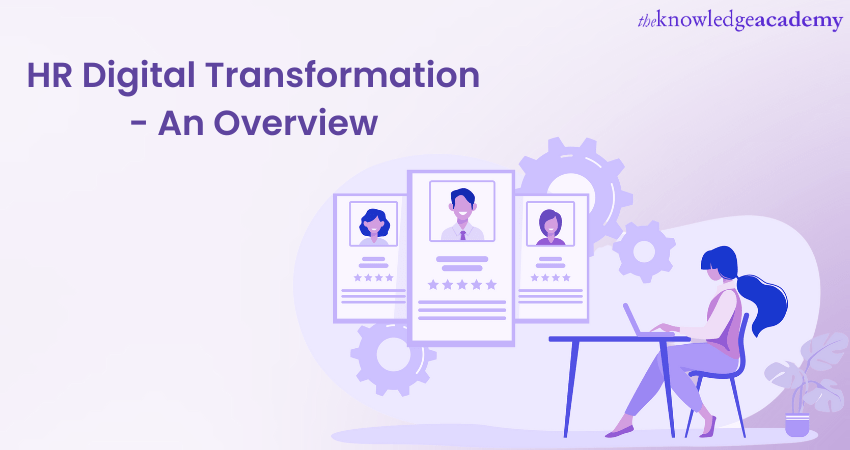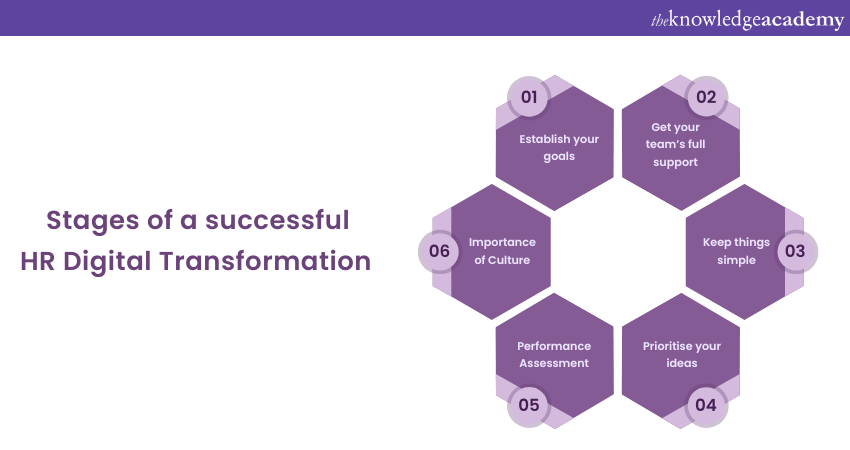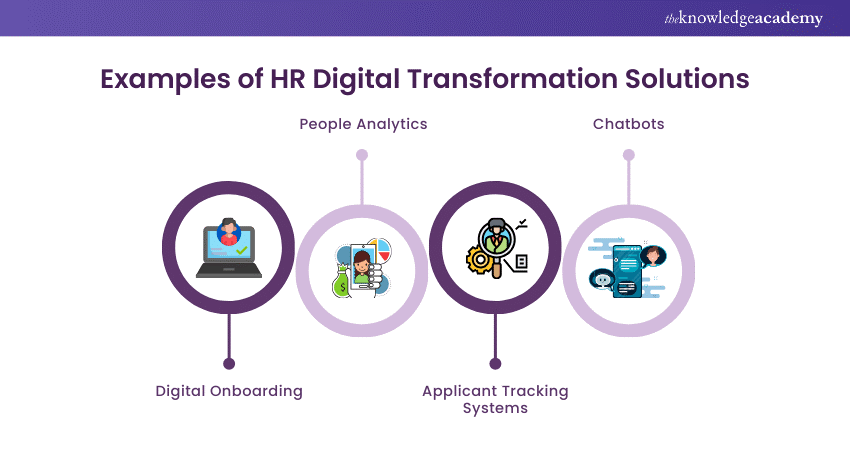We may not have the course you’re looking for. If you enquire or give us a call on 01344203999 and speak to our training experts, we may still be able to help with your training requirements.
Training Outcomes Within Your Budget!
We ensure quality, budget-alignment, and timely delivery by our expert instructors.

HR Digital Transformation has become a necessity for HR teams in any organisation. Traditional HR operations, including recruiting procedures, have become more automated. Moreover, HR software applications now provide data-driven insights from collected employee data, improving the quality of decision-making by HR teams, with the help of these Digital Transformation Tools.
According to a 2022 survey by PWC, 79% of organisations observed an accelerated Digital Transformation during the pandemic. This statistic illustrates the positive impact of COVID-19 on company processes. The same survey also noted that 96% of organisations perceive HR roles as employee experience designers. This blog will provide you insights on HR Digital Transformation and its importance, as well as how to take your organisation to the next level.
Table of Contents
1) Understanding HR Digital Transformation
2) Which factors are required for a successful Digital Transformation?
3) Stages of a Successful HR Digital Transformation
4) Examples of HR Digital Transformation solutions
5) Conclusion
Understanding HR Digital Transformation
Digital Transformation is the process of evolving from traditional operations to digitalising business solutions. When HR is included in this process, it changes recruitment procedures from manual to automated processes. It’s important for an organisation to understand the purpose behind digitising its HR processes. It's also crucial to note that a sudden shift from physical to digital HR processes will take time. Just like the saying ‘Rome wasn’t built in a day’, a complete HR Digital Transformation will not happen overnight. It will take its own time based on the organisation’s values and team-building goals.
A great example of HR Digital Transformation is the Applicant Tracking System (ATS). But why does an organisation need such a system? An ATS is a software application developed to scan resumes for specific keywords, helping recruiters identify the best applications from the rest. Recruiters used to have cabinets full of countless applications on their desks, which they had to manually sift through to filter out the best candidates. ATS systems, introduced in the 90s, were a turning point in the recruitment process for many companies. ATS systems were a blessing in disguise for recruiters, helping them keep track of records and improve information organisation for each applicant.
Since the introduction of ATS systems, both HR technology and recruitment processes have improved significantly. The rise of social media platforms and widespread internet use has led to a surge in online applications. This has brought two new factors to light in the recruitment process: the employee's brand identity and the candidate's experience. These factors have become crucial for the development of ATS systems, making them more evolved over time. ATS systems were very basic in their early stages, but with the integration of Machine Learning, they have taken on a brand-new face.
Some important goals of HR Digital Transformation include:
1) Automating processes and minimising time spent on repetitive activities
2) Improving the employee experience
3) Utilising free time to create strategies that benefit the business in the long run
Before we proceed, let us understand the distinctions between Digitisation, Digitalisation, and Digital Transformation? Let’s take a brief look at each of them:
Digitisation
The basic meaning of Digitisation is the conversion of physical information into digital information. Physical information, also referred to as analogue information, is converted into a binary format that can be understood by any computing system. Examples of digitisation include scanning documents, recording audio and visuals information, optical character recognition, and so on. These examples all involve the process of mapping physical or analogue information into digital bits that can be processed by a system with computing capabilities.
Digitalisation
Let us now discuss the term “Digitalisation” What is Digitalisation? It refers to the use of digital technology to generate new revenue and opportunities, resulting in a shift from a physical to a digital business model. While the terms "Digitisation" and "Digitalisation" are often used interchangeably, they have distinct meanings and intentions. “Digitisation” involves converting information from an analog form to a digital form, whereas “Digitalisation” is about transforming existing business processes into a digital format.
A great example of Digitalisation is when a team maintains shared meeting documents on a cloud server for all members to access and edit. The team would need to invest in a cloud storage subscription and integrate it with digital workspace tools to enable access anytime and anywhere.
Digital Transformation
Since Digital Transformation has taken the world by a storm, let us understand What is Digital Transformation? Digital Transformation is a term that refers to the positive impact of digitalisation. Transformation typically signifies a positive change in the state of something. When any process undergoes transformation, it brings about a change to the equilibrium of its initial state, resulting from advancements in technology and the intentions of the team.
Which factors are required for a successful Digital Transformation?
Digital Transformation is a complex process which requires planning, execution and management. Here are some factors which are necessary for a successful Digital Transformation:
a) The organisation must have good leadership for Digital Transformation to take place. Leaders who can articulate and carry out the vision clearly can help in aligning the organisation’s overall strategy.
b) A digital culture is extremely crucial, as it helps in embracing change efficiently.
c) In Digital Transformation, focusing on customer experience is important. This helps in understanding what are the needs and preference of customers using the digital technologies, which helps in enhancing customer experience.
d) There should be a well aligned digital strategy which will help in achieving business goals as well. The strategy will act as a roadmap for implementation of the objectives and business goals.
e) The organisation needs to establish in the right technology which includes Cloud Computing, Data Analytics, cybersecurity measures, etc. These will help in maintaining agility and scalability.
Stages of a successful HR Digital Transformation

Undertaking an HR Digital Transformation can be a challenging process, but your organisation can benefit by following a few important steps, such as:
Establish your goals
The first and foremost step to kickstarting your HR Digital Transformation journey in recruitment is to establish clear-cut goals. Your goals should make complete sense from a business-oriented perspective. Typically, the goal defined is to address a concern faced by your employees.
Tackling the concerns of your employees should be the main focal point of your HR transformation process. Your employees will be the end-users of your Digital Transformation, as they can test the new technology before it is deployed and implemented.
Get your team’s full support
Gaining the full support of your team, including your stakeholders and investors, is crucial. The HR Digital Transformation will impact your entire organisation, and it is important to ensure that everyone is on the same page regarding the journey. Any misunderstandings or disagreements can be discussed and resolved through mutual understanding. Discussions can bring any concerns or conflicts to the forefront and help ensure that everyone understands the importance of the transformation.
Keep things simple
The HR Digital Transformation process may seem intimidating, but the HR managers and recruitment teams can work together to leverage their strengths. Teamwork should begin by starting small and simple. The team can start by identifying areas of the existing HR process that need to be digitalised, such as preselection procedures, candidate recruitment, onboarding, learning and development, and payroll management.
Prioritise your ideas
Brainstorming for HR Digital Transformation may result in a long list of ideas. To avoid choice paralysis, it is better to narrow down the ideas based on their impact and the effort required. Impact refers to the overall business impact of digitising the ideas, while effort refers to the budget and time investment required for implementation.
It is usually a good idea to start with ideas that require the least effort and have the highest impact. Starting with these types of ideas will help the HR team build business use-cases for digital recruitment and drive the momentum of the transformation process.
Performance sssessment
Once your team has implemented and established its Digital Transformation process, the next step is to conduct routine assessments. Assessments are done to ensure that your team stays on track with its short-term goals. When your team achieves its checkpoints, it can benefit from reassessing its technology implementations. It is important for your organisation to prioritise solving necessary problems.
Importance of culture
In addition to Digital Transformation, the mindset of your team is equally important. Your team is a powerful force for your company. To maintain the momentum of your team in achieving its digital HR goals, the company culture should be nurtured from the time of onboarding. New hires joining the company need a supportive hand in integrating into the culture.
The hiring team should ensure that new hires fit the personality and image of the organisation, in addition to possessing the required technical skills they. New hires should be trained to be adaptable and capable of delivering optimal quality over time.
Learn to execute the core responsibilities of an HR Manager. Sign up for the Certified HR Manager Course now!
Examples of HR Digital Transformation solutions

Let’s discuss some key examples of Digital Transformation solutions to get a better idea of the areas where the transformation has permeated:
Digital onboarding
Digital Onboarding refers to the process of virtually onboarding new hires. Virtual recruitment became the norm during the pandemic phase, where hiring teams could conduct recruitment processes completely online. The majority of workers who were freshly hired after the beginning of the pandemic had never worked on site. After working virtually during the pandemic, workers may experience anxiety upon entering the physical workplace. According to Glassdoor, quality onboarding improves the retention of new hires by over 80%.
Building a company culture where new hires and existing members are virtually present requires the team to readapt its company culture accordingly. Effective digital onboarding can encourage new hires from different departments to interact with one another. Encouragement and proper guidance can translate to greater retention of new hires, especially in virtual environments.
People analytics
When HR processes are integrated with data-driven decisions, employees experience increased productivity and higher performance quality. People analytics is utilised by organisations to leverage their decision-making processes in recruitment, talent management, and employee retention.
Analytics is a term generally associated with data rather than culture. However, organisations can utilise the insights provided by data-based analytics as a pivot for their HR digital transformation. Recruitment teams can leverage their learning and development strategy by utilising data insights. As a result, the hiring team can improve their upskilling and reskilling goals, leading to better employee satisfaction.
Learn the Data Analysis and manage and store your data better using the R tool. Sign up for the Data Analytics with R Course now!
Applicant Tracking Systems
The tedious process of screening countless resumes coming in from job listings has led to the development of Applicant Tracking Systems (ATS). According to a study by Ideal, over 85% of candidates turn out to be underqualified from a pool of about 200 applications. Additionally, the task of screening resumes takes up over 20 hours for every hire, according to the same study.
The development of ATS software applications ensures that recruitment teams screen every applicant in the competitive market. Efficient and fast screening is even more important considering the number of professionals switching job profiles. The ATS software is designed to filter out unqualified applicants based on keywords, skills, experience, and other criteria. As a result, recruiters only get to view the most qualified candidates, significantly increasing their hiring efficiency.
However efficient and smart an ATS is considered, it is possible for qualified candidates to be unintentionally removed from the applicant pool. To address this concern, advanced ATS software like FreshTeam by Freshworks is designed to analyse the accepted applicants and carry out deeper filtering based on resume nuances.
Moreover, an ATS can significantly reduce the unconscious bias present in humans during hiring procedures. Factors such as gender, creed, age, or ethnicity are eliminated from the picture, levelling out the inconsistencies on the playing field. As a result, interviews become more diverse and competency-based without involving any personal preferences.
Chatbots
Chatbots are efficient software programs built to provide immediate responses to both generic and commonly asked questions. What makes them stand out for an organisation’s recruiting front is that they can give auto-responses to the most frequently asked questions.
HR chatbots collect employee information as and when necessary. More importantly, the collection of information can be done asynchronously. The HR chatbot essentially simulates human dialogue between employees and candidates. The simulation automates the screening of candidates, interview scheduling, and other tasks.
HR chatbots are known to be AI-supported to process data from conversations and provide appropriate responses. They can also resolve user queries across various subjects like a company’s culture and policies.
Learn the tools to successfully implement Digital Transformation in your organization. Sign up for the Digital Transformation Certification Course now!
Conclusion
HR Digital Transformation helps traditional HR operations to slowly convert into automated and data-driven processes. All stakeholders in an organisation must be involved for a successful transformation. A clear vision and precise measurement of an organisation’s digital transformation are very important factor for success.
It will be very beneficial if an organisation prioritises its ideas and conducts performance assessments regularly. And above all, the right company culture will greatly benefit employees in the long term.
Learn the fundamentals of Human Resources and the necessary health and safety regulations at the workplace. Sign up for the Introduction to HR Course now!
Frequently Asked Questions

HR can drive Digital Transformation by fostering a culture of innovation, upskilling employees with digital competencies, recruiting talent with essential digital skills, implementing Agile workforce strategies, and ensuring organisational structures support digital ways of working.

HR digitalisation streamlines processes, enhances employee experience, improves data-driven decision-making, and boosts operational efficiency, enabling HR to focus on strategic roles and better support the organization's overall digital transformation.

The Knowledge Academy offers various Digital Transformation courses, including Digital Transformation Certification. These courses cater to different skill levels, providing comprehensive insights into Digital Transformation methodologies.
Our Business Improvement blogs covers a range of topics related to Digital Transformation, offering valuable resources, best practices, and industry insights. Whether you are a beginner or looking to advance your Digital Transformation skills, The Knowledge Academy's diverse courses and informative blogs have you covered.

The Knowledge Academy takes global learning to new heights, offering over 30,000 online courses across 490+ locations in 220 countries. This expansive reach ensures accessibility and convenience for learners worldwide.
Alongside our diverse Online Course Catalogue, encompassing 17 major categories, we go the extra mile by providing a plethora of free educational Online Resources like News updates, Blogs, videos, webinars, and interview questions. Tailoring learning experiences further, professionals can maximise value with customisable Course Bundles of TKA.

The Knowledge Academy’s Knowledge Pass, a prepaid voucher, adds another layer of flexibility, allowing course bookings over a 12-month period. Join us on a journey where education knows no bounds.
Upcoming Business Skills Resources Batches & Dates
Date
 Digital Transformation in HR Training
Digital Transformation in HR Training
Fri 13th Sep 2024
Fri 6th Dec 2024







 Top Rated Course
Top Rated Course



 If you wish to make any changes to your course, please
If you wish to make any changes to your course, please


